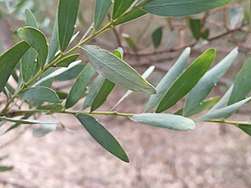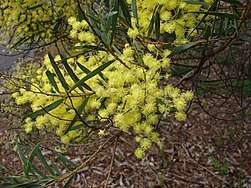Acacia prominens
Acacia prominens (golden rain wattle, goldenrain wattle, Gosford wattle or grey sally)[2] is a shrub or tree in the genus Acacia native to New South Wales, Australia.[3]
| Golden rain wattle | |
|---|---|
 | |
| Scientific classification | |
| Kingdom: | Plantae |
| Clade: | Tracheophytes |
| Clade: | Angiosperms |
| Clade: | Eudicots |
| Clade: | Rosids |
| Order: | Fabales |
| Family: | Fabaceae |
| Clade: | Mimosoideae |
| Genus: | Acacia |
| Species: | A. prominens |
| Binomial name | |
| Acacia prominens | |
 | |
| Occurrence data from AVH | |
| Synonyms | |
Description
Acacia prominens usually grows to a height of 5 to 9 m (16 to 30 ft), sometimes to a height of 20 to 25 m (66 to 82 ft).[3] It has glabrous branchlets that are angled at the extremeties and has smooth grey coloured bark. Like most species of Acacia it has phyllodes rather than true leaves. The grey-green to grey-blue, glabrous to sparsely hairy phyllodes have a narrowly elliptic to narrowly oblong-elliptic shape and are more or less straight. The phyllodes are 2.5 to 6 cm (0.98 to 2.36 in) in length and 5 to 12 mm (0.20 to 0.47 in) wide with a prominent midvein. It blooms between July and September producing inflorescences in groups of 5 to 25 in an axillay raceme with spherical flower-heads that have a diameter of 3 to 5 mm (0.12 to 0.20 in) containing 8 to 15 lemon yellow to pale yellow coloured flowers.[4]
Taxonomy
The species was first formally described by the botanist Allan Cunningham in 1832 as part of George Dons work A General History of Dichlamydeous Plants. It was reclassified as Racosperma prominens by Leslie Pedley in 2003 then tranferred back to genus Acacia in 2006.[5] The species epithet refers to the prominent exerted gland on the margin of the phyllode, about 5 to 20 mm (0.20 to 0.79 in) above the pulvinus.[4] It is most closely related to A. kettlewelliae and A. covenyi.[3]
Distribution
It is endemic to south eastern Australia in New South Wales and also found in Victoria. In New South Wales it is found from around the Hunter Valley in the north west to the Gosford and Sydney areas in the south east. It is often situated in damp and sheltered areas growing in loamy and clay soils along the margins of rainforest or as a part of wet sclerophyll forest communities.[4] It is naturalised to parts of central Victoria including the goldfields, greater Grampians, Gippsland Plain and northern inland slopes.[6]
Alkaloids
It contains the psychoactive alkaloids phenethylamine and β-methylphenethylamine.[7][8]
Image gallery
 Phyllodes with prominent glands on margins
Phyllodes with prominent glands on margins
See also
References
- P.G. Kodela. "New South Wales Flora Online: Acacia prominens". Royal Botanic Gardens & Domain Trust, Sydney, Australia.
- "Acacia prominens (Gosford Wattle)". Archived from the original on 20 August 2012. Retrieved 13 September 2010.
- Orchard, Anthony E.; Wilson, Annette J. G. (2001). Flora of Australia: Mimosaceae Acacia. CSIRO Publishing. p. 326. ISBN 978-0-643-06718-9. Retrieved 13 September 2010.
- ""Acacia prominens A.Cunn. ex G.Don"". PlantNET – New South Wales Flora Online. Royal Botanic Gardens & Domain Trust, Sydney Australia. Retrieved 26 February 2020.
- "Acacia prominens A.Cunn. ex G.Don". Atlas of Living Australia. Global Biodiversity Information Facility. Retrieved 27 July 2020.
- "Acacia prominens A.Cunn. ex Don Gosford Wattle". VicFlora. Royal Botanic Gardens Victoria. Retrieved 27 July 2020.
- Fitzgerald, J.S. (1964). "Alkaloids of the Australian Legumuminosae – The Occurrence of Phenylethylame Derivatives in Acacia Species" (PDF). Aust. J . Chem. 17: 160–162.
- Hegnauer, Robert (1994). Chemotaxonomie der Pflanzen. Springer. p. 500. ISBN 3-7643-2979-3.
External links

